SEO insights tell you how your website and its content perform in search engine results. They help you fine tune your content strategy, so your website can rank higher and offer a better user experience.
In this article, we’ll share practical SEO insights and free tools to improve your content strategy and increase organic traffic in 2023 and beyond.
7 Best SEO Insights to Improve Your Content Strategy in 2023
Search engine algorithms and user behaviors keep changing.
Which means search marketers need to keep up.
Our State of Search report found that even though Google released fewer updates in 2022, fluctuations in keyword rankings were higher compared to 2021.
This could be because Google has become more effective at fighting spam and removing irrelevant domains from its index.
There’s also the possibility that people have abandoned domains they created at the start of the pandemic, while authoritative brands have improved their rankings for more keywords with fewer pages.
It’s clear: what worked last year might not cut it anymore. And staying abreast of these algorithm updates and ever-evolving SERPs is a must if you want to bring in more organic traffic.
Let’s dive straight into seven SEO insights you need to know:
1. Satisfying Search Intent Is More Important Than Ever
Search intent (or user intent) is the reason why a user types a query into a search engine. To show up in the search results, your content needs to match people’s search intent.
For example, if someone wants to buy a website address and searches for “buy domain name,” your content should help them find and buy domain names.
A blog post explaining what a domain name is would be too high-level. Because it doesn’t align with what people actually look for when they use those keywords.
There are four types of search intent:
- Navigational: Searchers finding a specific website
- Informational: Searchers looking for information
- Commercial: Searchers doing research before making a purchase
- Transactional: Searchers wanting to make a purchase.
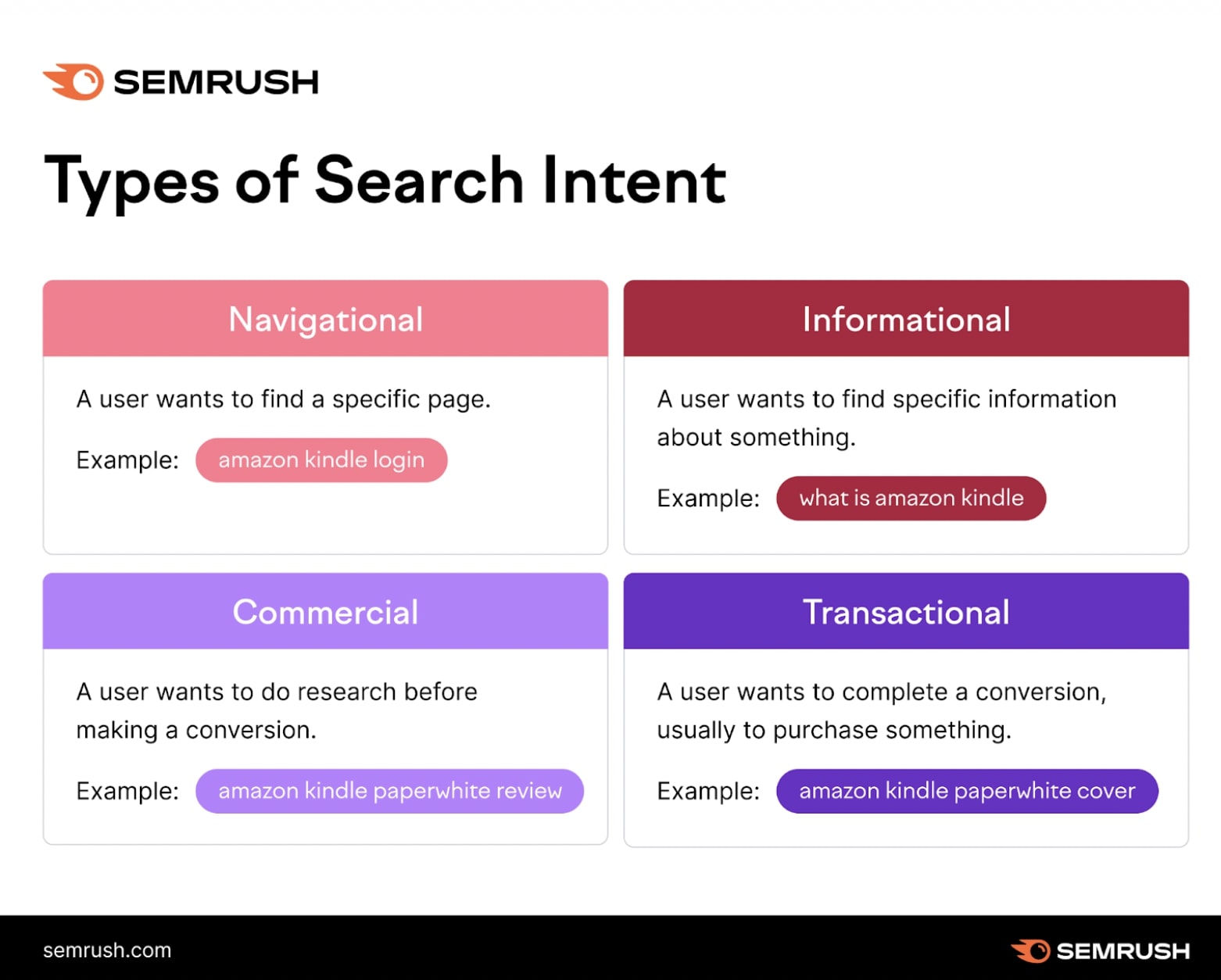
Matching search intent matters because Google’s all about giving people what they want. Its general guidelines (PDF), published in December 2022, have a whole section dedicated to understanding search users, queries, and results.
When your content perfectly aligns with what users search for, it’s a win-win:
- Higher ranking: Google’s algorithm recognizes when your content is a perfect match for what a user searches for. This increases your chances of ranking higher in the search results.
- Better user experience: When a user finds your content matches their intent, it improves brand trust and means they’re more likely to visit your site again when they need an answer to a similar question
For example, let’s say you want to rank for “global payroll providers.” Type the keyword into Google and you’ll see the top-ranking results are curated lists of global payroll providers.
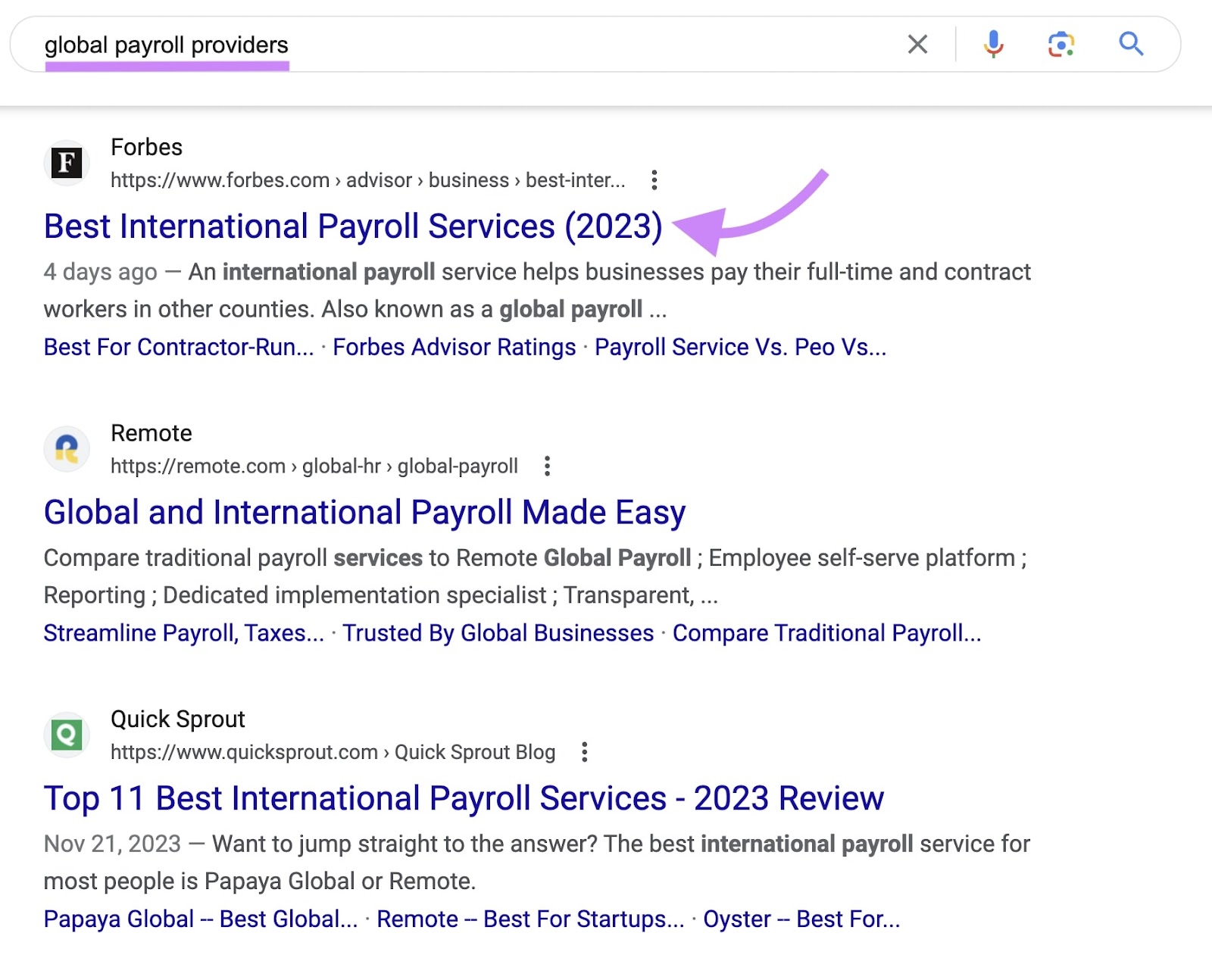
What does this mean?
When people search for “global payroll providers,” they want to see options or recommendations.
This is one of the reasons People Managing People’s article listing the “26 Best Global Payroll Service Providers of 2023” ranks highly for this keyword. It aligns with search intent and helps people make an informed decision.
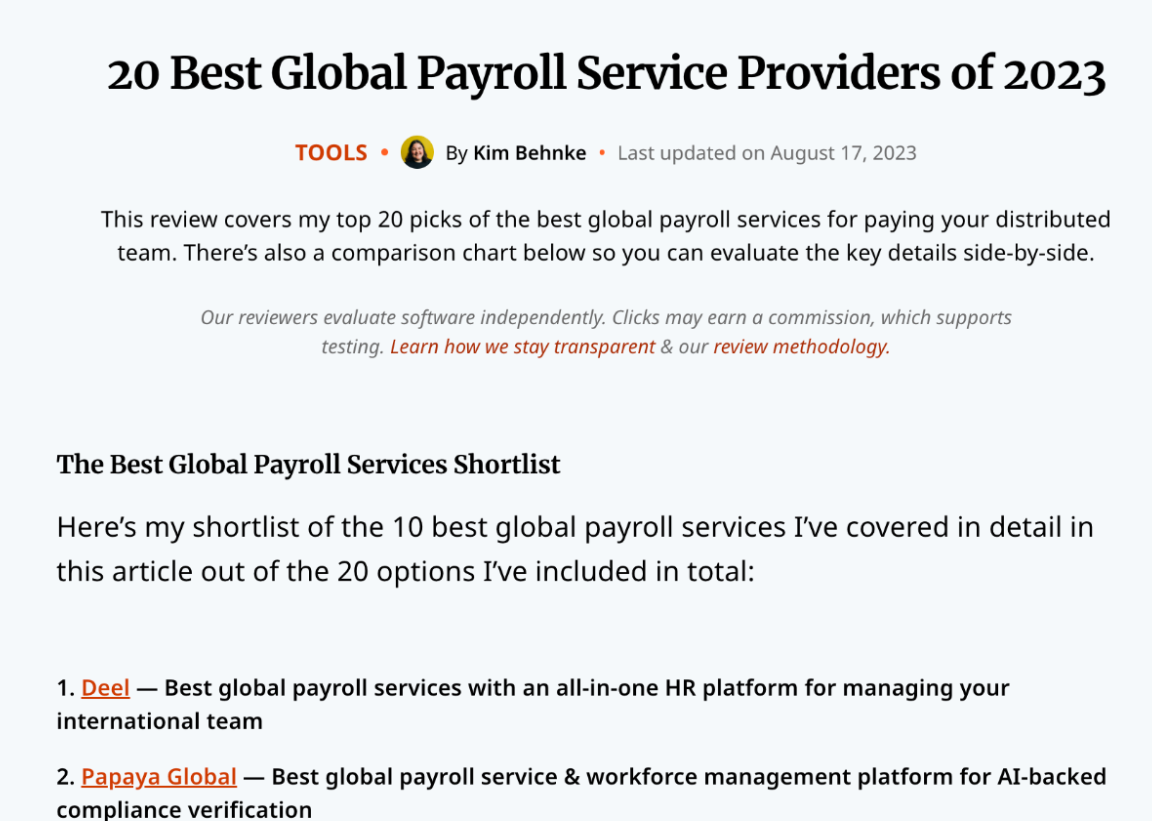
For the same reason, Papaya Global’s article, “Global Payroll: Challenges & Solutions” doesn’t appear in the first few pages. It talks about the challenges and solutions of global payroll and fails to meet the search intent.
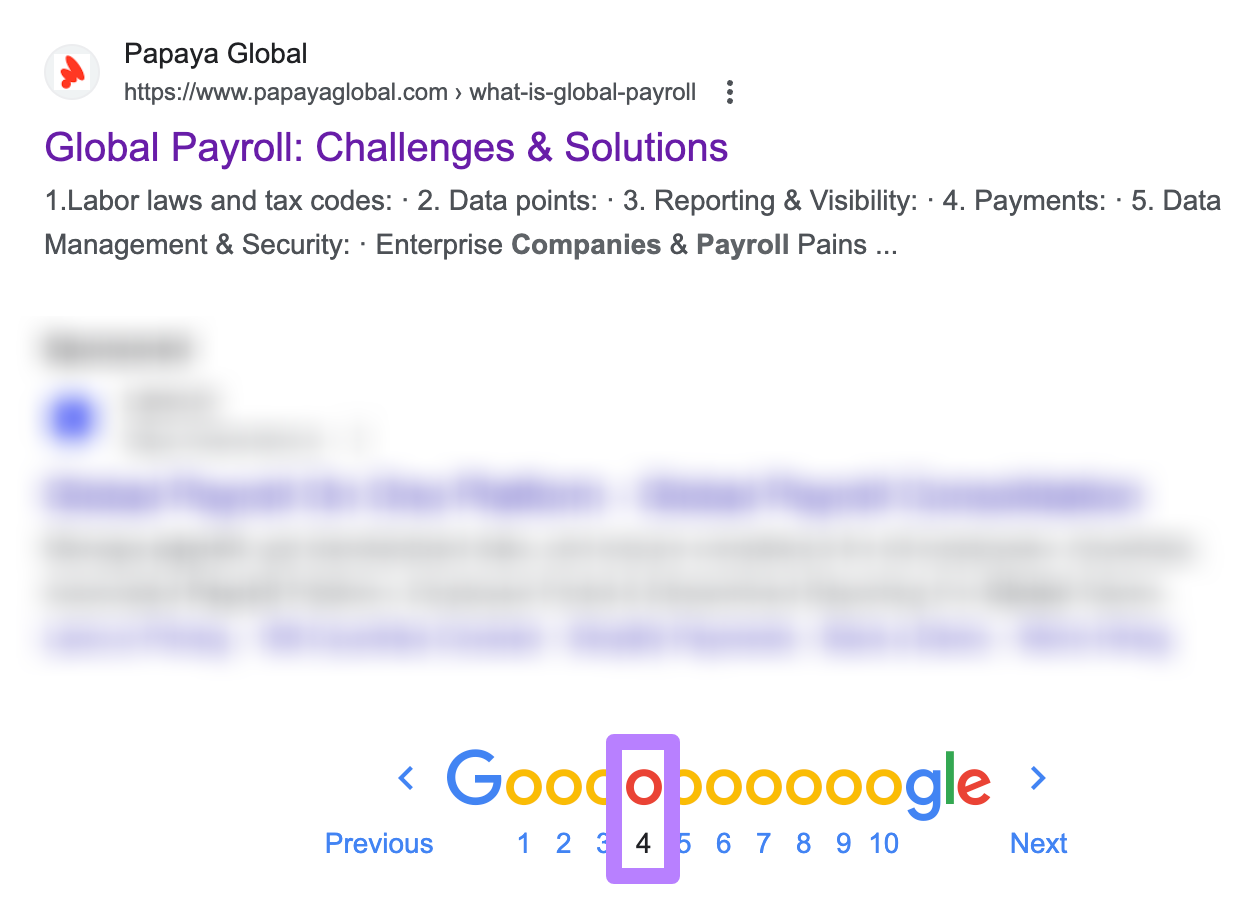
So, how do you determine search intent?
Open Semrush’s Keyword Overview tool.
Enter your keyword, click “Search,” and you’ll see a box named “Intent.”
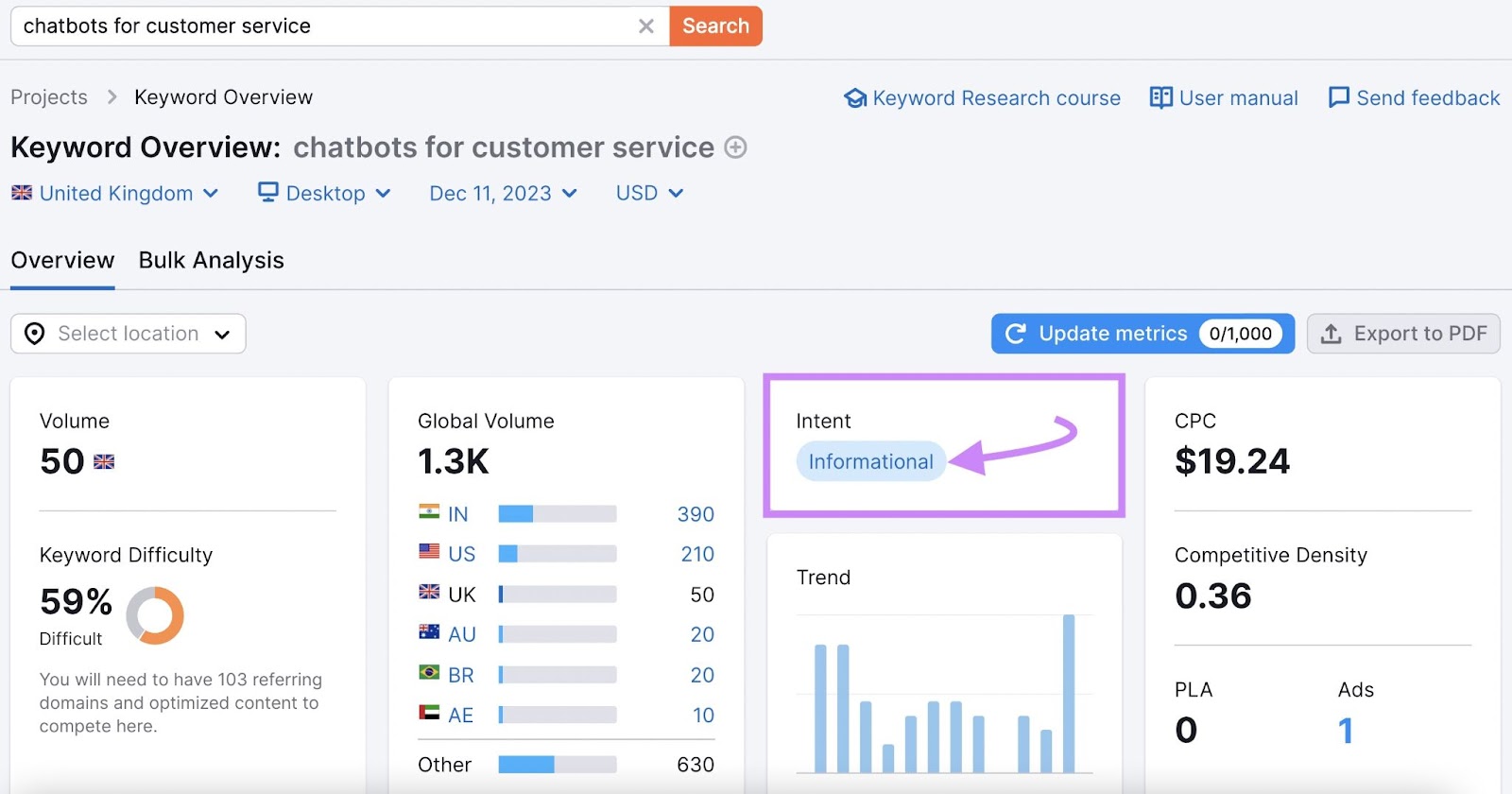
Here, we see the intent for “chatbots for customer service.”
Notice how it labels the intent as “Informational.” This tells us people want information on a specific topic or issue. They want to learn more. So high-ranking content likely answers tons of questions.
Speaking of:
Scroll down, and you’ll see Keyword ideas and a list of Questions:
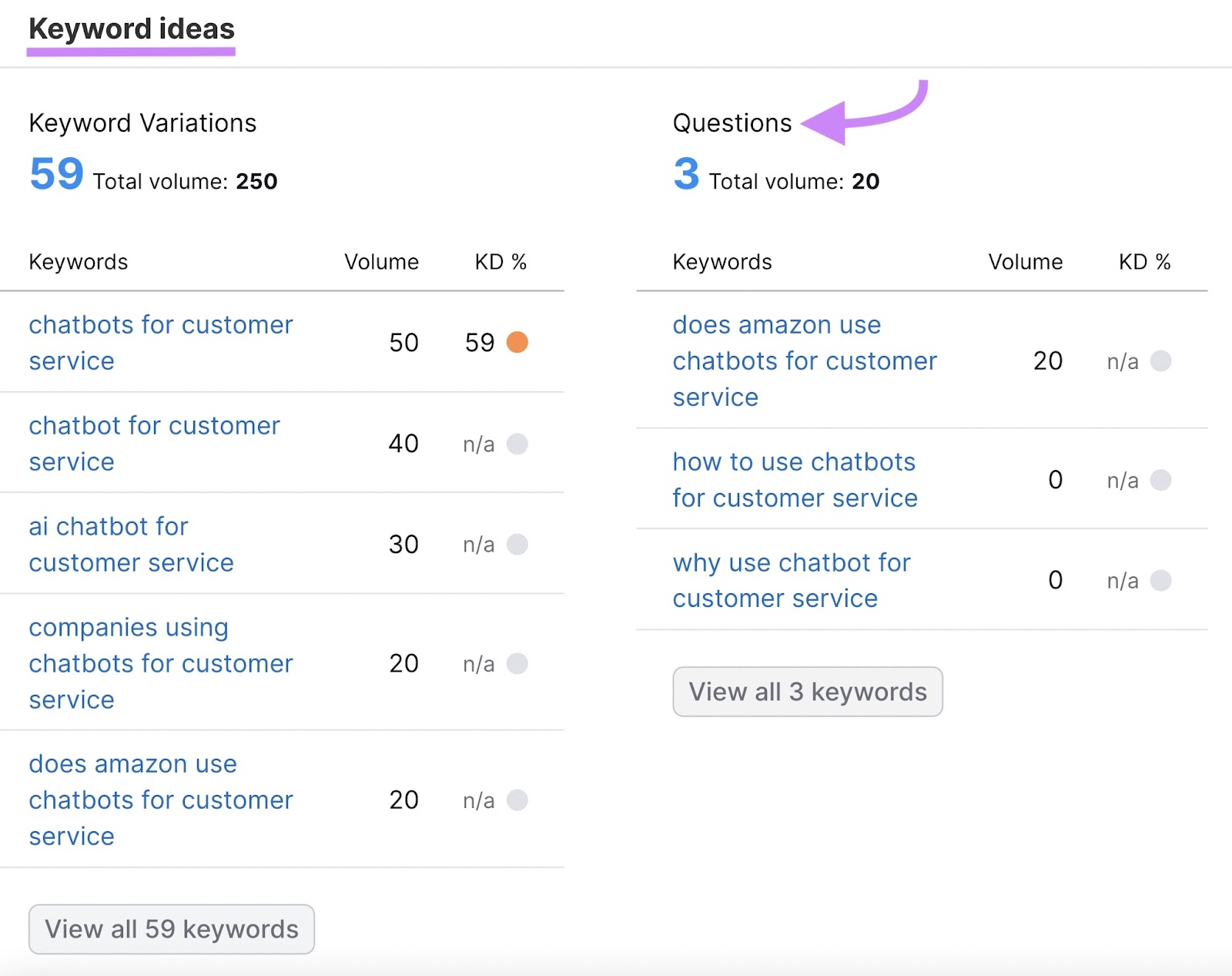
These are searches and questions related to the main keyword. You can use this information as a jumping-off point for your research and outline.
2. Analyze SERP Features to Boost Your SEO Game
SERP features are the additional elements you see on a search engine results page apart from the organic search results. They provide more information or options, which improves the search experience.
Some common SERP features include:
- Featured snippet
- Local pack
- Reviews
- Sitelinks
- Videos
- Images
- Top stories
- Knowledge panel
- People Also Ask (or More to Ask)
- Related searches
- Google Ads
- Rich snippets
For example, this is what the SERP looks like for “how to track employee training.” You can see the featured snippet:
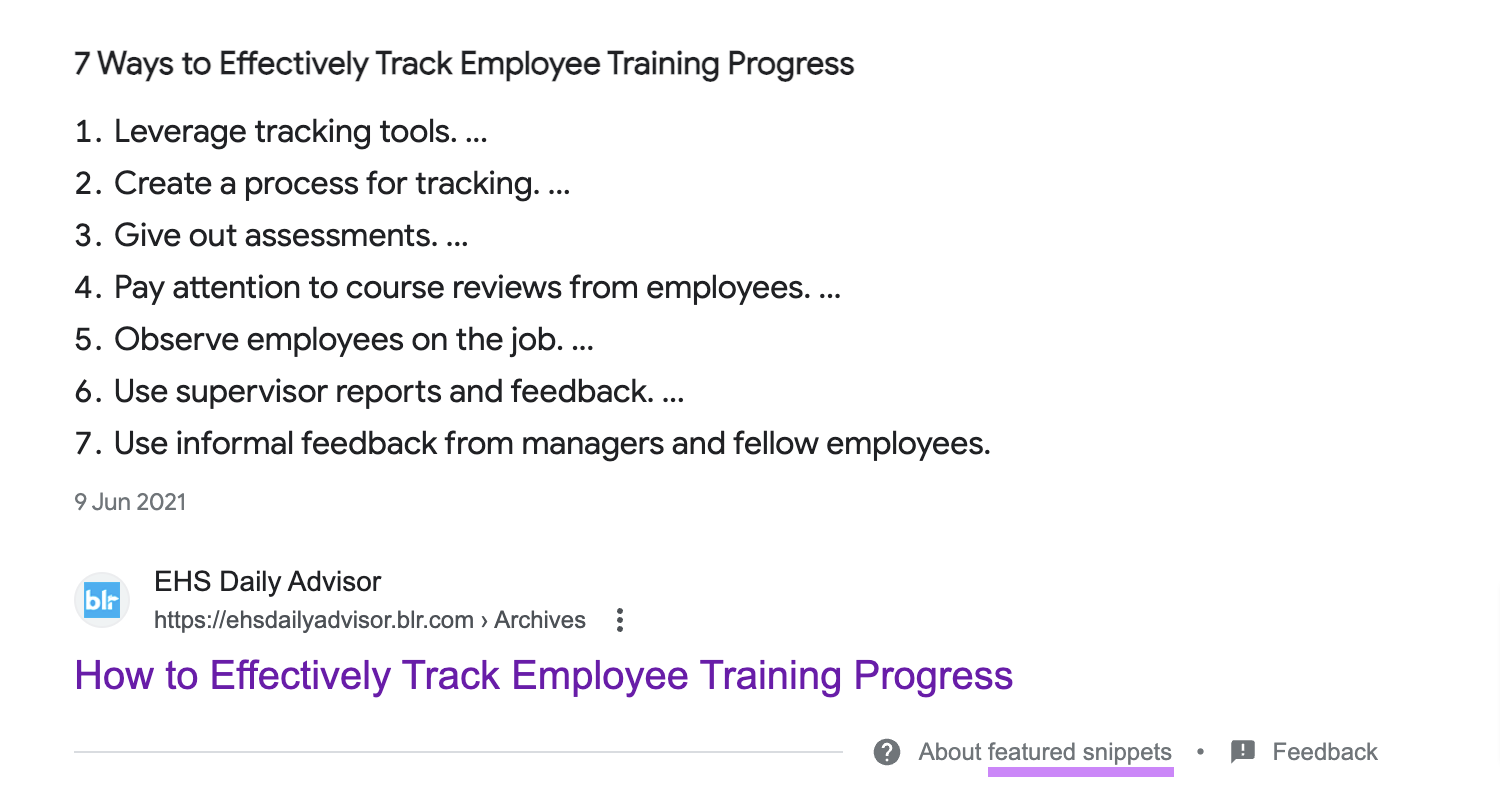
The “More to ask” (or “People also ask”) section:

Paid ads:
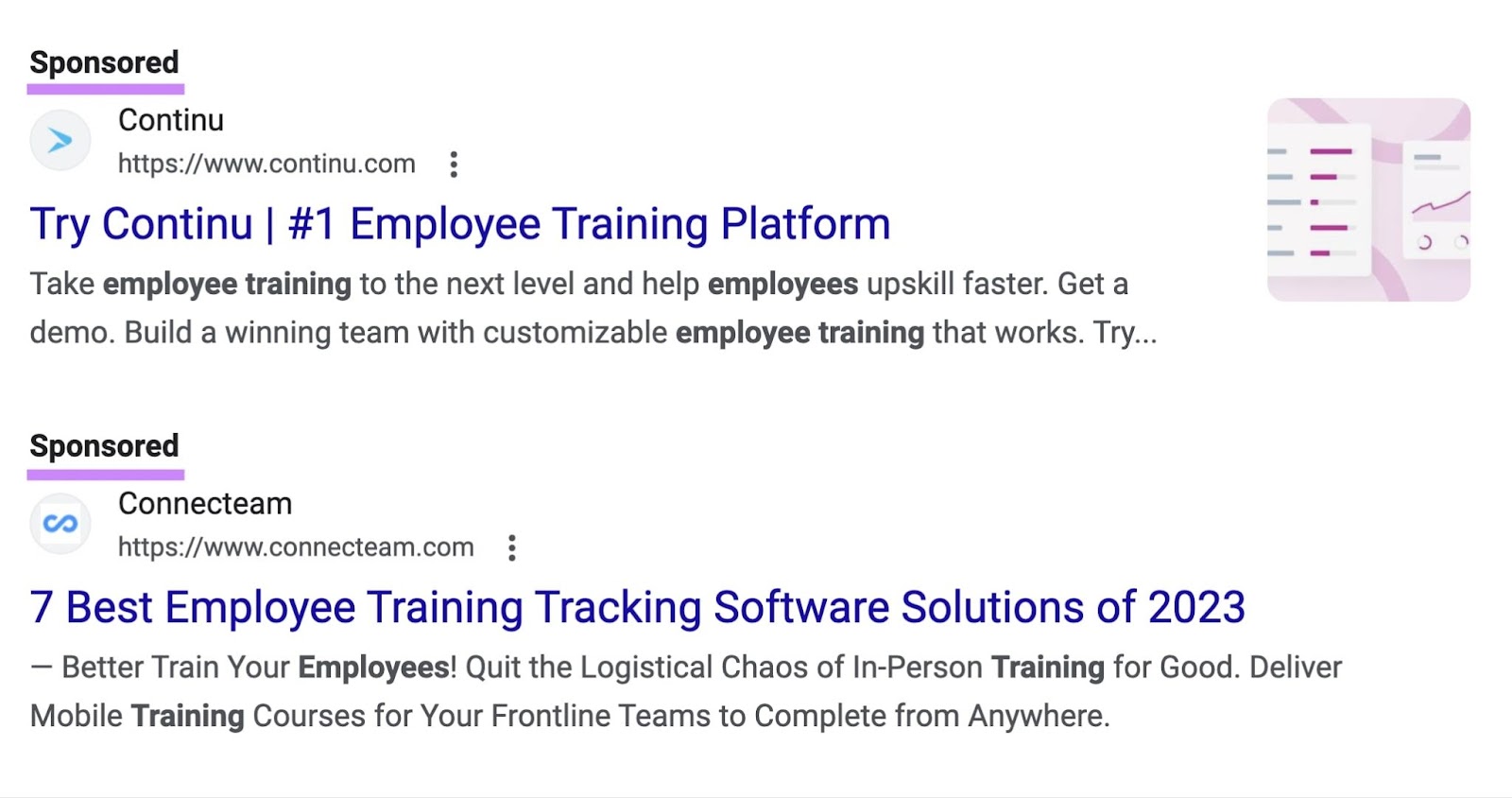
And related searches:
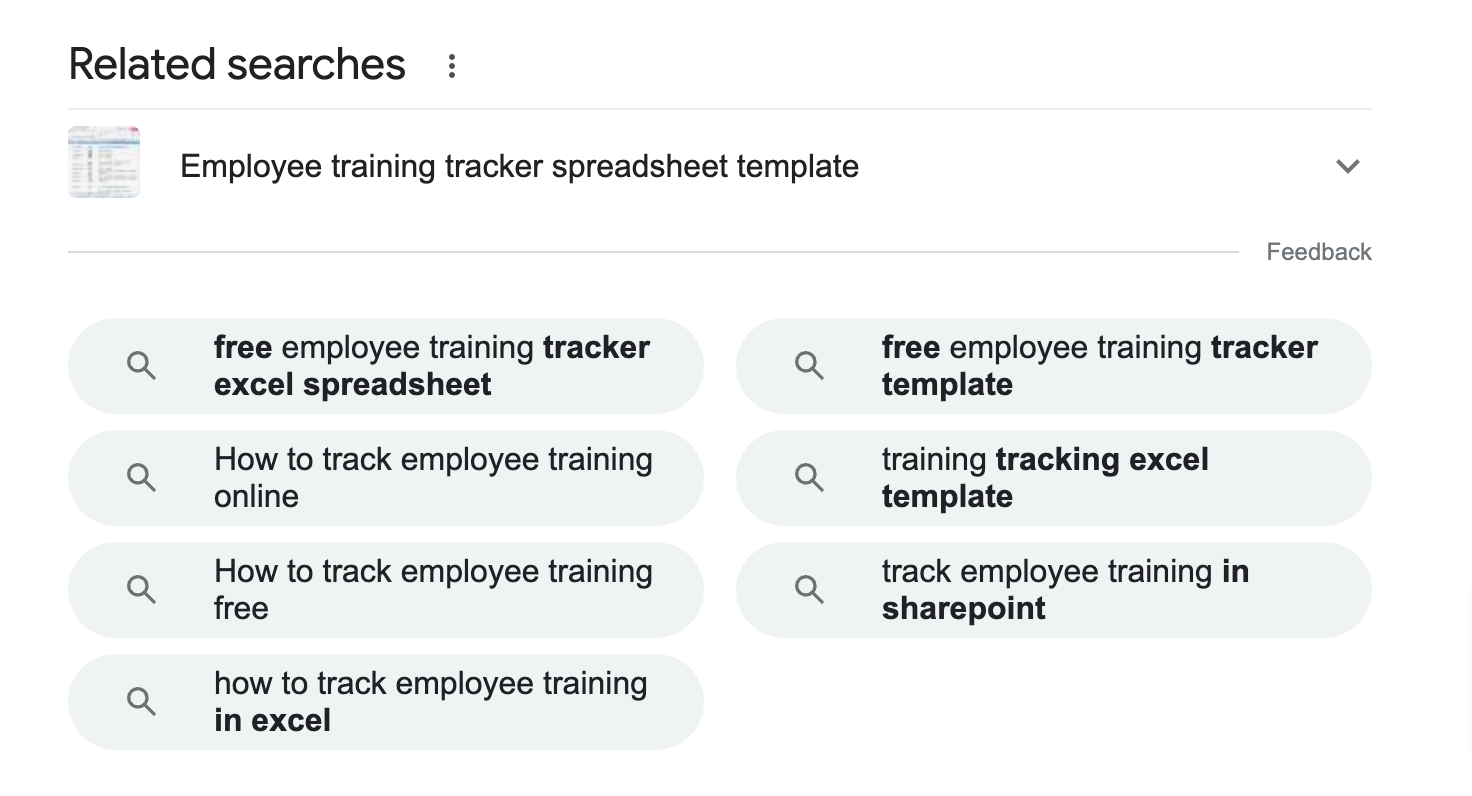
According to our zero-click study, 25% of desktop searches and 17.3% of mobile searches end without a click.
SERP features help Google deliver information to people quickly and easily.
Here’s how to improve your content’s chances of getting featured:
Analyze SERP features
This helps you understand what catches people’s attention and compels them to click.
For instance, look at the “More to Ask” section to find relevant questions related to your topic.
Then, use the insights to create content that directly addresses those questions. This way, your content is more likely to appear in that section—and get clicked.
Take a look at the example below. “How much does it cost to build a whole website” is one of the questions that appears in the “More to Ask” section for the keyword “how to build a website.”
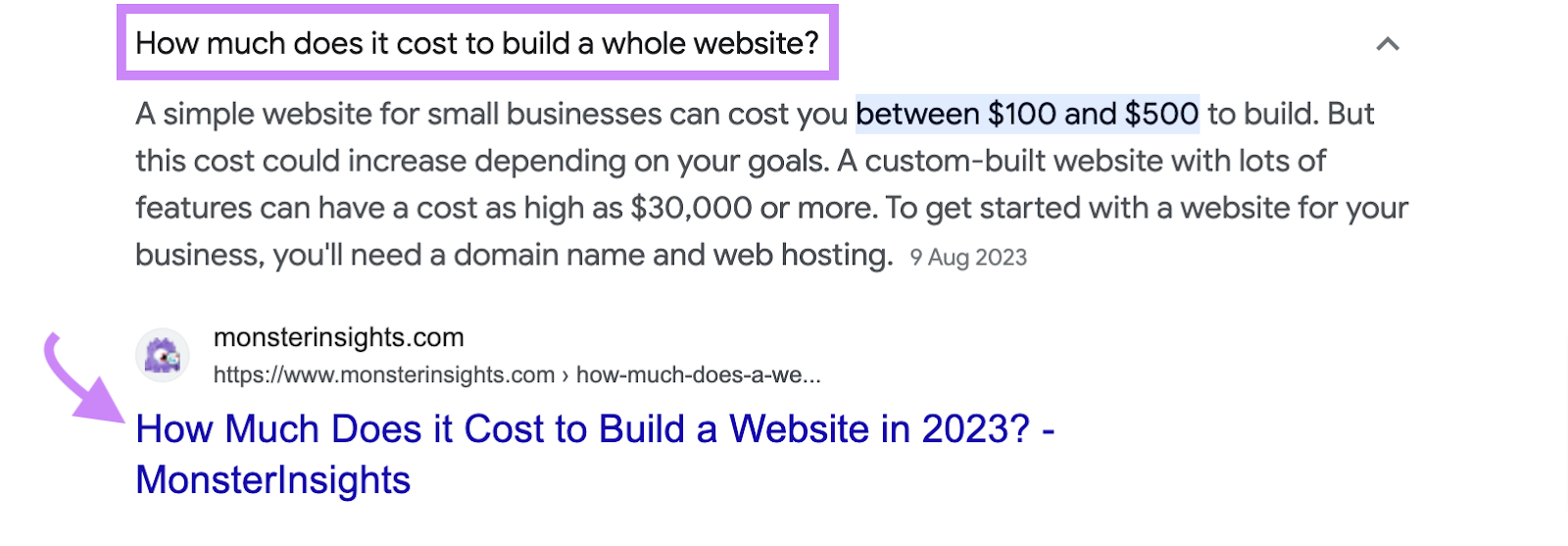
People may click on that MonsterInsights article because the answer positions the website as an authority on the topic.
Avoid zero-click searches
Find keywords that don’t have instant answers at the top of the SERP. These have higher click potential because they don’t appear as a SERP feature.
Take the keyword, “payment protection insurance,” for example. It doesn’t have a featured snippet (or instant answer). All people see is a list of organic search results.
Here lies your opportunity.
You can create informative content around this keyword and aim to rank high in the organic search results.
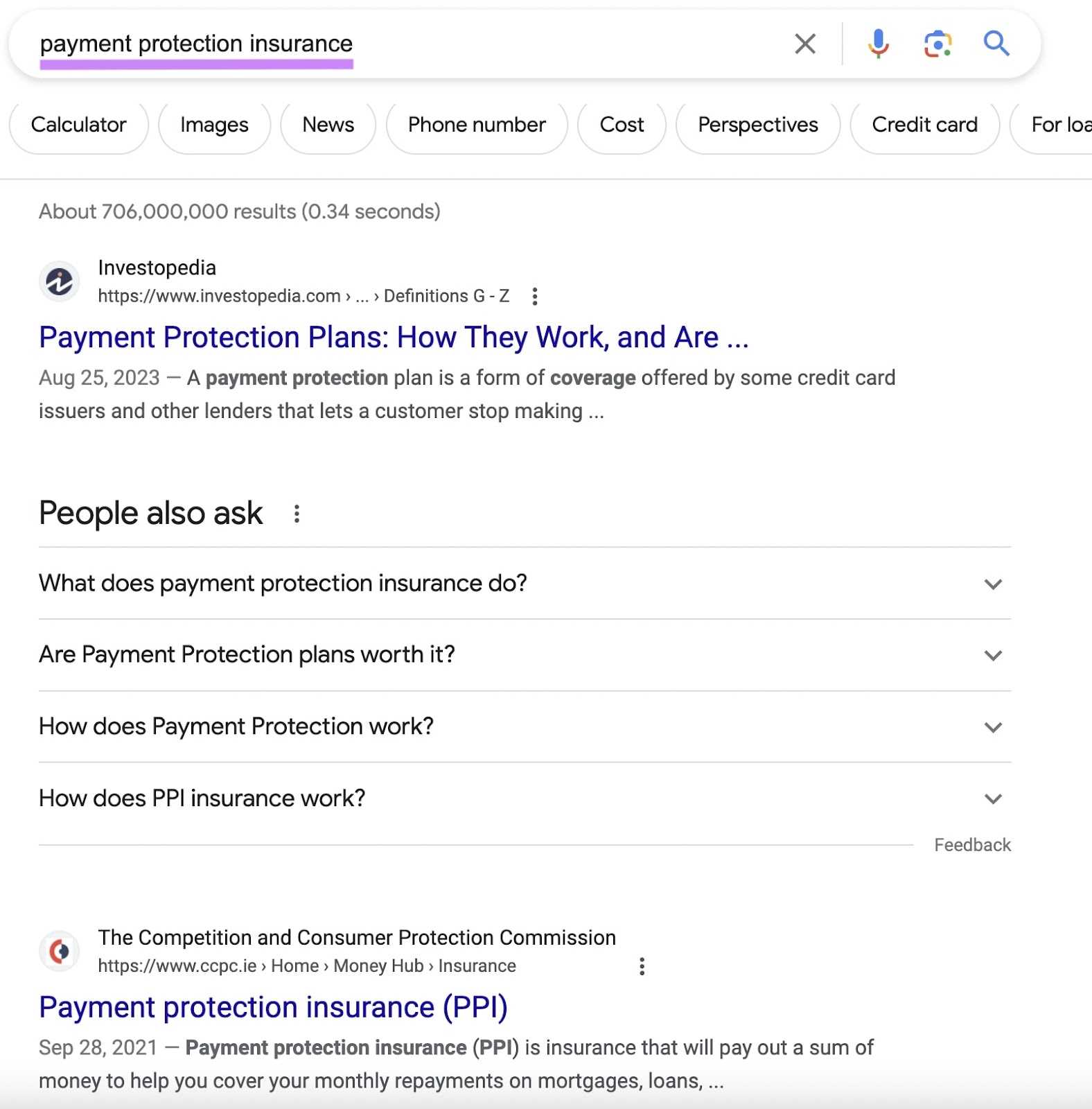
Further reading: Avoiding Zero-click Searches to Get More Traffic
3. Get a Competitive Edge with Long-Tail Keywords
Long-tail keywords are search queries that are highly specific with relatively low search volume.
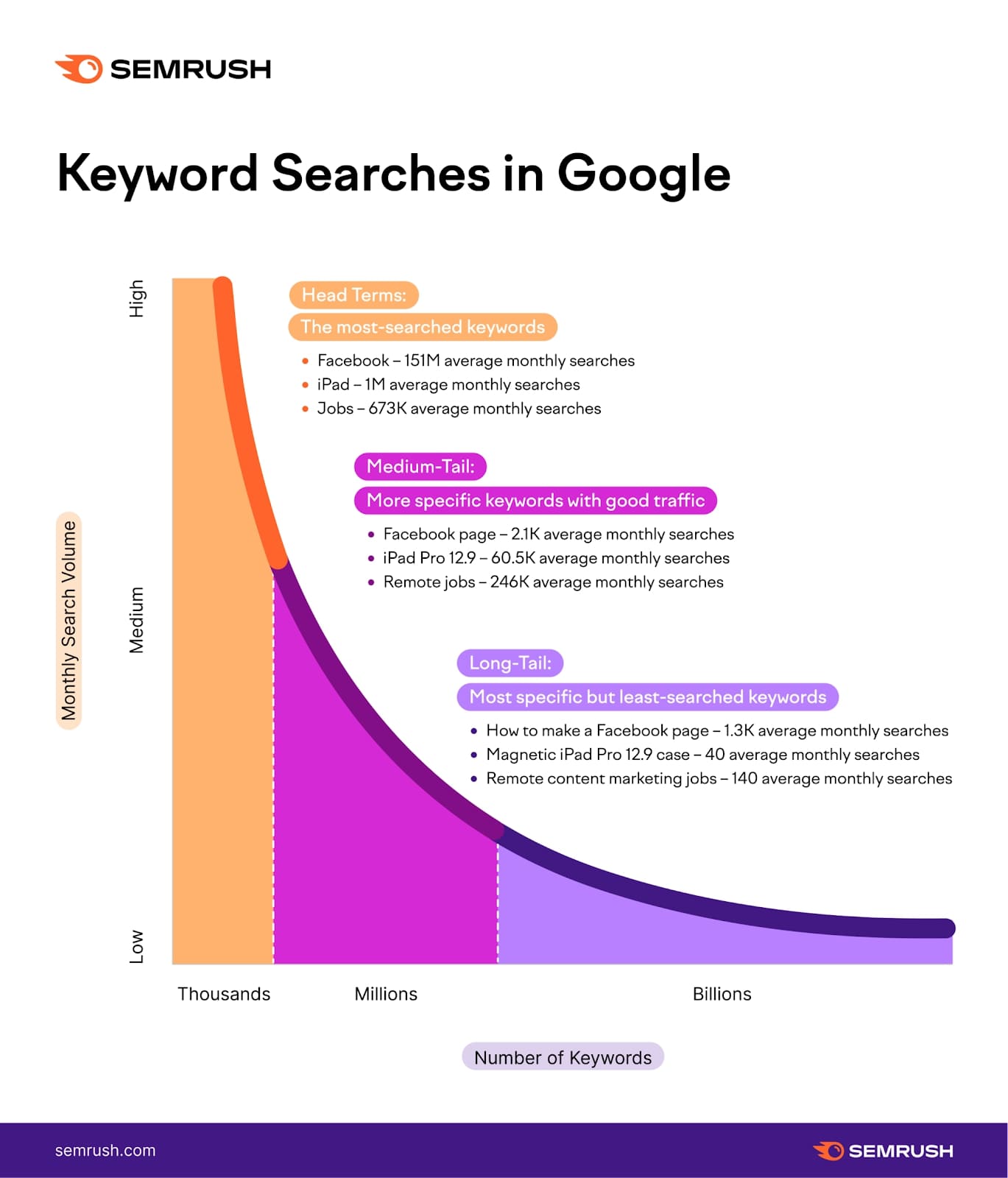
People who use specific search queries have a clearer idea of what they want and are likely closer to taking action (eg. making a purchase, filling out a form, etc.). This brings in higher quality traffic from more qualified leads, leading to more conversions.
For example, if you target a short-tail keyword like “project management tool,” you’ll likely attract a broad audience. People early in the research phase are less likely to convert.
If you target a long-tail keyword like “project management tools in software engineering,” you’ll likely to attract people who have moved beyond the initial research phase.
Long-tail keywords are also generally easy to rank for because there’s less competition.
You can discover long-tail keywords in the “Related searches” section of the SERP. For example, here are specific queries related to “internal communications plan.”
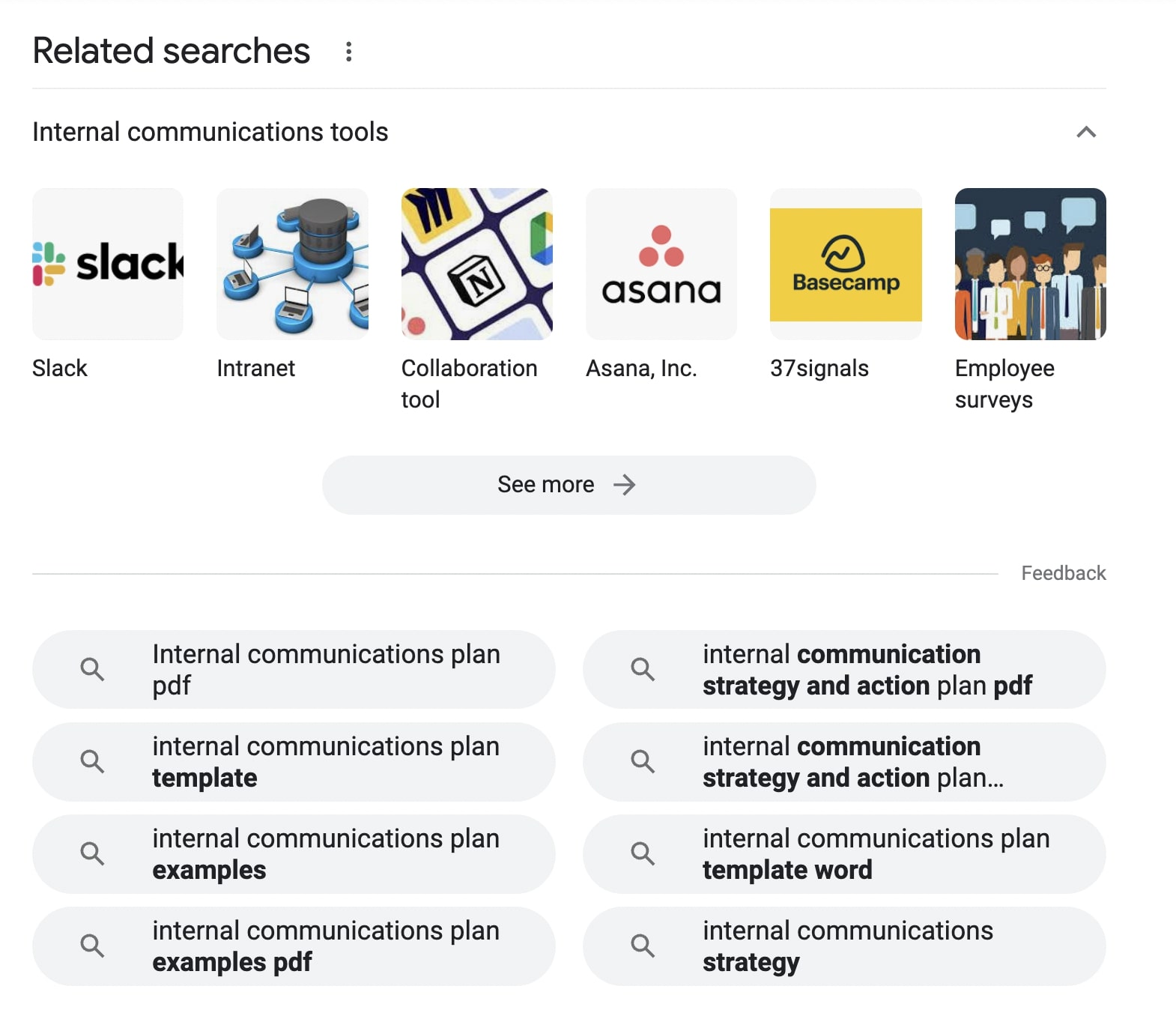
In Semrush’s Keyword Overview tool, we see “internal communications plan” has a 46% Keyword Difficulty:
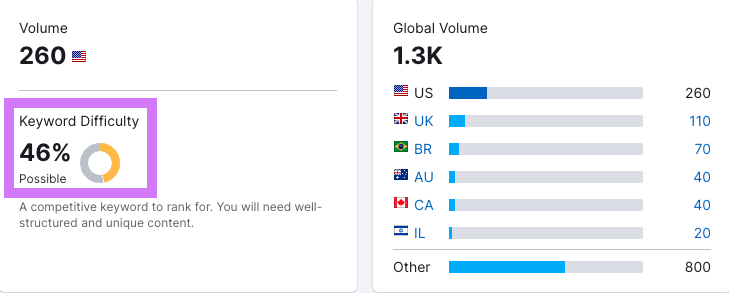
The long-tail query “internal communications plan examples pdf” is much lower at 13%:
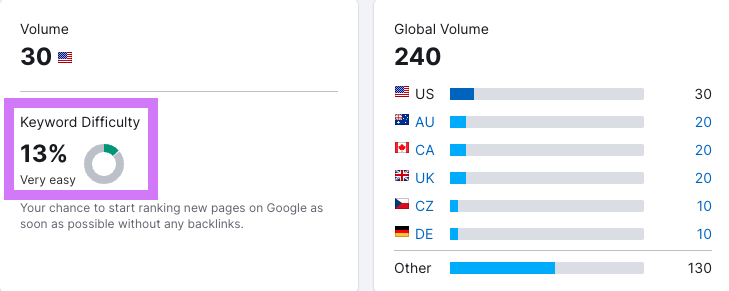
So, long-tail keywords are generally easier to rank for.
4. Create Content for Humans, Not Machines
Google prioritizes content that people find genuinely helpful.
Helpful, people-first content addresses your target audience’s needs, answers their questions, and helps them find the information or solutions they need.
When your content is helpful, it builds trust. People might return to your site for more information or take an action, such as signing up for newsletters, making purchases, or contacting your business.
Here are some practical tips to create quality content that stands out:
- Get to know your audience: Understand your audience’s pain points and motivations to create content that resonates with them
- Showcase expertise: Involve subject-matter experts and create original, expert-driven content to boost credibility
- Find the right formats: Use the right formats for your content so that it’s engaging and effective (eg. blog posts, podcasts, videos, etc.)
- Ensure content readability: Write short and simple sentences, use images to break up long sections, and share relevant information first to make content easy to read and digest
This blog post on driving empathy in design with user feedback by Hotjar is a good example of quality content. It addresses a crucial topic in design—empathy-driven design, which is highly relevant today.

It’s written in a conversational tone, making it approachable and easy to understand. It also includes diagrams and screenshots to help you grasp the key points.
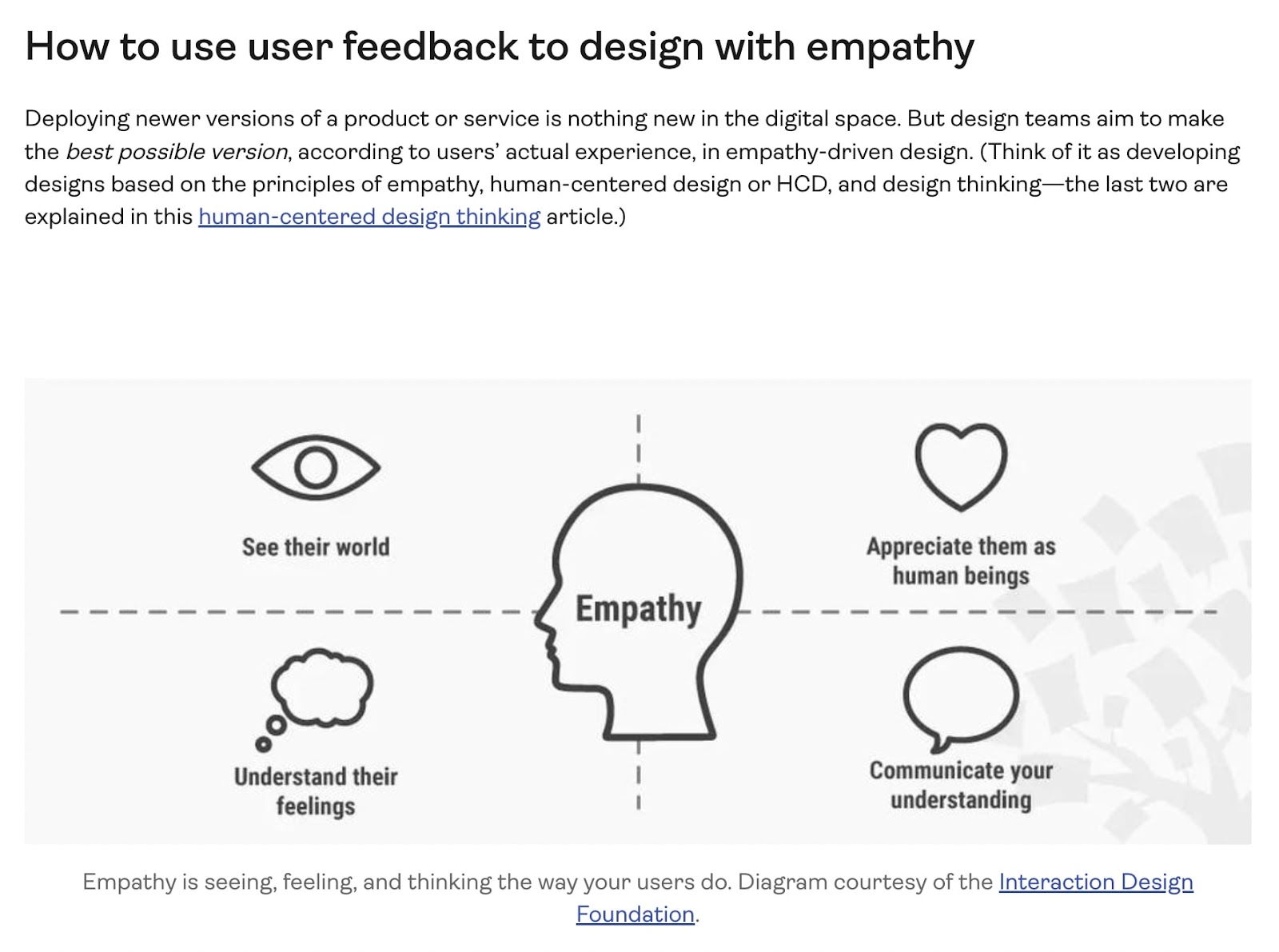
To make the user experience even better, Hotjar added a reading progress bar and an “On this page” floating widget. These features help you easily navigate and engage with the content.
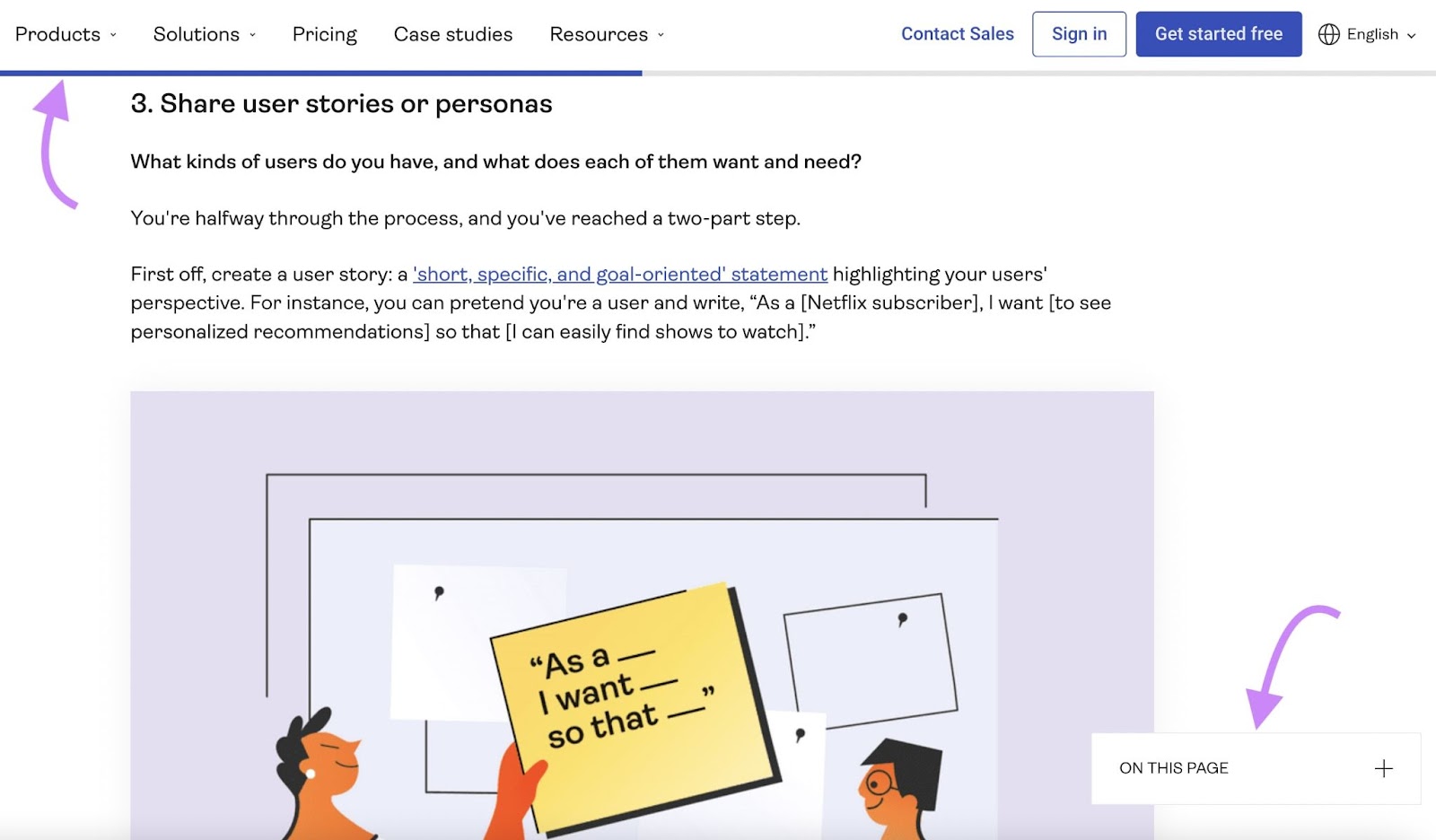
5. Show, Don’t Tell: Why You Need to Demonstrate Firsthand Experience
Google’s E-E-A-T (Experience, Expertise, Authoritativeness, and Trustworthiness) guidelines stress the importance of content created by authors who have hands-on experience with the subject matter.
Another important factor is expertise, such as a qualification in a certain field. For example, someone who’s a certified financial advisor writing a personal finance blog.
Authors with firsthand experience and expertise tend to provide accurate and trustworthy information packed with personal insights.
The bottom line: Google wants to ensure that the person who wrote the content is a reliable source.
Here are some ways to show firsthand experience while creating content:
- Author bios: Include author bios or create dedicated pages showing their qualifications and past wor
- Credible sources: Link to reputable sources such as studies, research papers, etc.
- Guest authors: Collaborate with guest authors who have experience in the topic
- Real-life examples: Share real-life stories and case studies that reflect your experience
- Behind-the-scenes: Describe how you created a piece of content for added transparency
- Expert review of content: Build authority and show expertise with expert analysis. For example, a doctor reviewing medical content
Intercom is a good example. It largely features blog posts written by experts who draw from their own experiences to provide practical advice and insights to readers.
For instance, you can find articles authored by Intercom’s VP of customer support. His firsthand experience in customer support adds credibility to the content. Intercom also includes a clear author bio, establishing his credentials and expertise in the field.
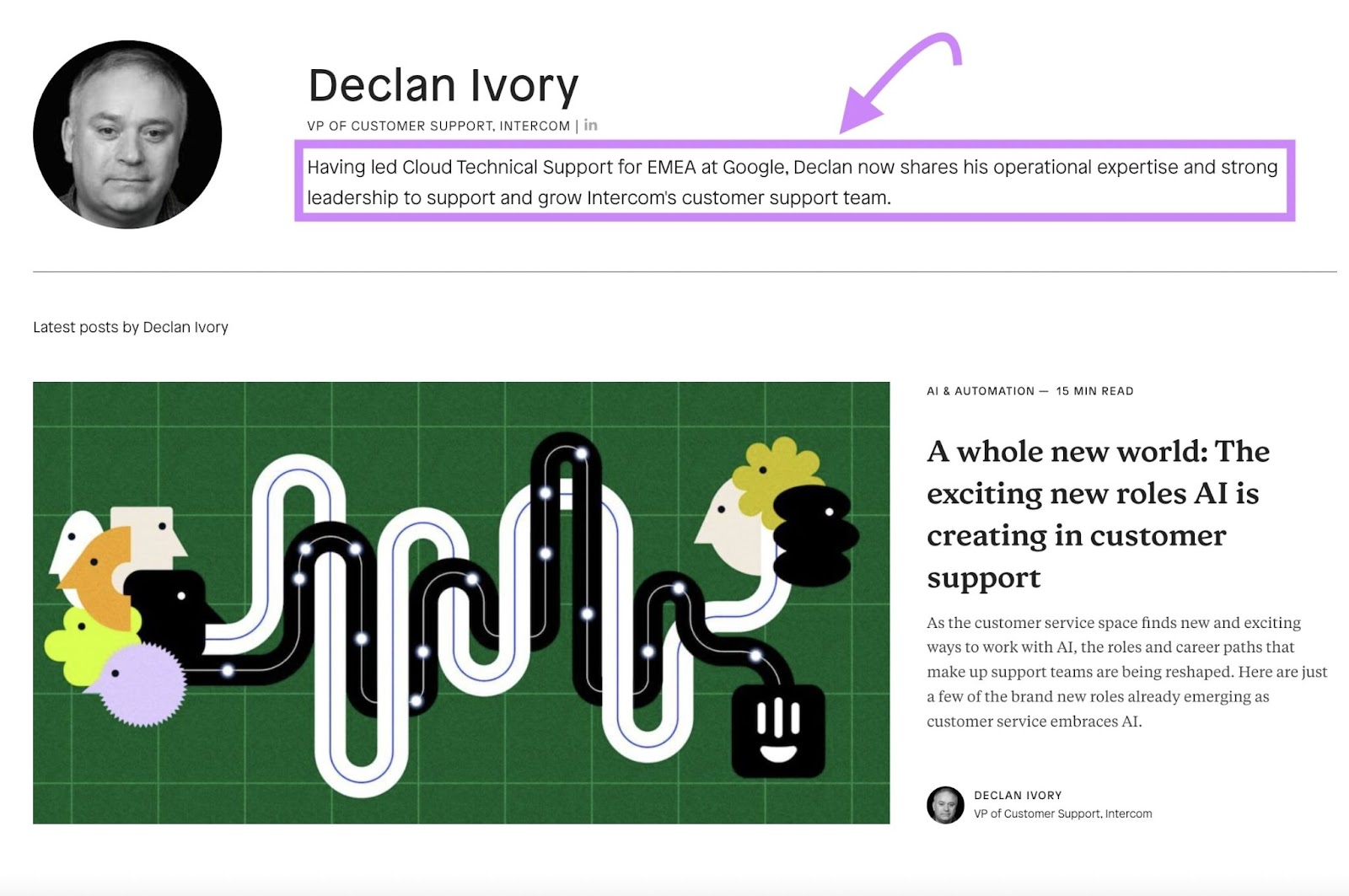
6. Optimized Images Give You More SEO Impact
When you optimize your images for search, you improve your chances of ranking higher on Google Images. This means more eyes on your visuals, more website visits, and a better chance of people discovering your content (or products).
But here’s the kicker: Visuals don’t only appear on the Images page. They show up on the main search results page, too.
This way they grab attention right where people search for information. Which gives your content an even better chance to get noticed.
For example, these are the images that appear on the main SERP for “ecommerce conversion funnel.”
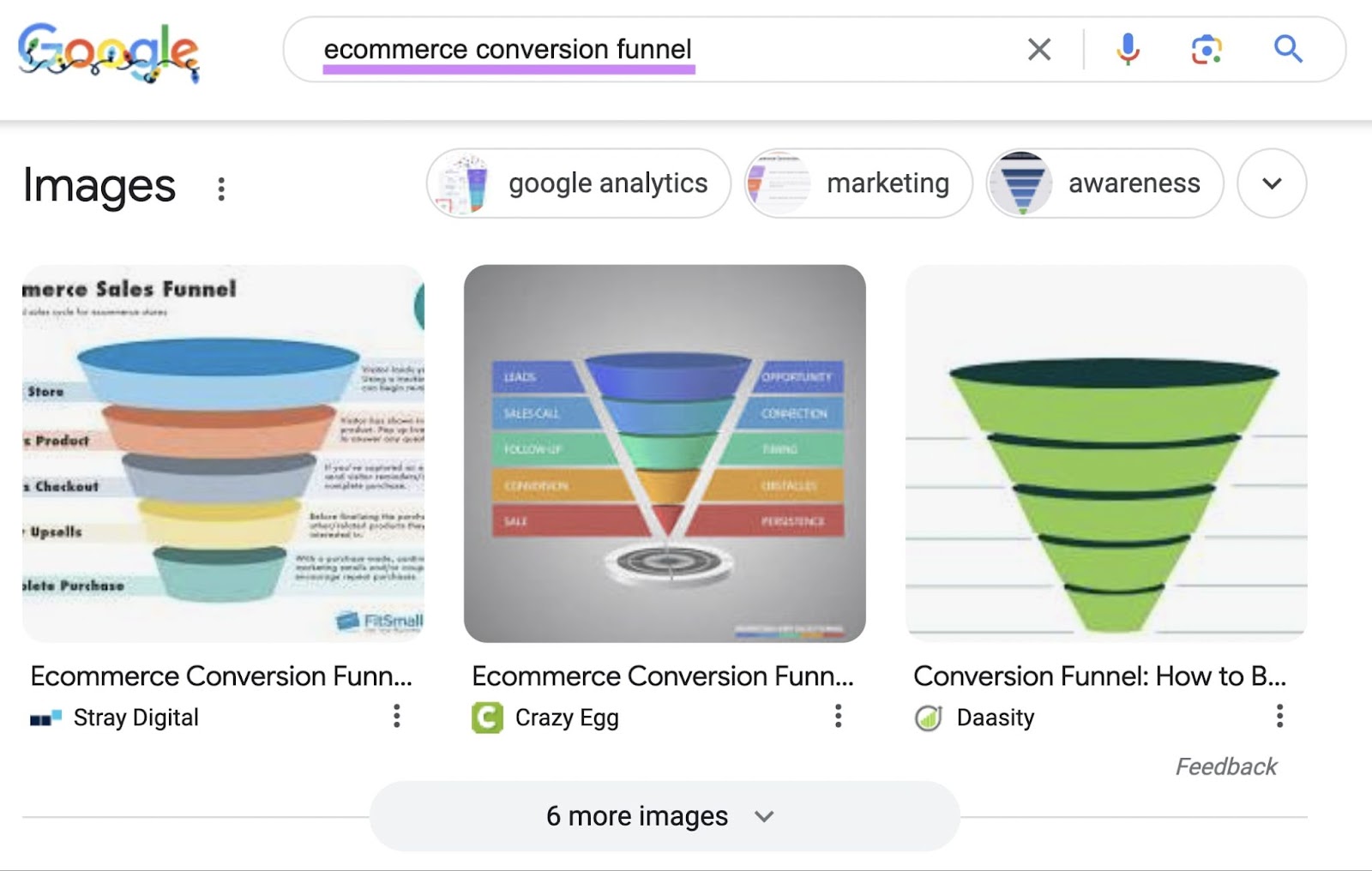
Image optimization doesn’t just boost your website’s visibility in search results. It also makes your images more accessible, your site load faster, and your content more engaging. Here’s how to improve your image SEO:
- Descriptive alt texts: Write specific descriptions for images (eg. “internal-communication-tools” instead of something generic like “IMG123”)
- Image compression: Reduce image size to increase page speed
- Image formats: Choose suitable image formats (eg. JPEG, PNG, SVG, or WebP)
- Sitemap: Create an image sitemap to increase your chances of appearing in the Image results
- Structured data: Use structured data to help search engines better understand your website’s content
Further reading: Read our Image SEO guide to learn how it can get more traffic to your site.
7. One High-Quality Backlink Beats Many Irrelevant Ones
Backlinks are links on one website that point to another website. They’re one of Google’s most important ranking factors.
According to our 13-month study, nearly all (92.3%) of the domains that rank in the top 100 have at least one backlink.
But link building is not about collecting a bunch of backlinks anymore. It’s about having natural, high-quality ones from reputable websites.
When these websites link to your content, it shows that others trust and value what you have to offer. It’s like a vote of confidence in your website.
Plus, search engines value them because they see high-quality backlinks as a sign that your content is a reliable source of information.
All this can lead to higher search engine rankings, more visibility, and more organic traffic.
For example, Layoffs.fyi, a company that tracks layoffs in tech startups, has received external links from authoritative websites like TechCrunch and BBC—all thanks to their original and valuable content.
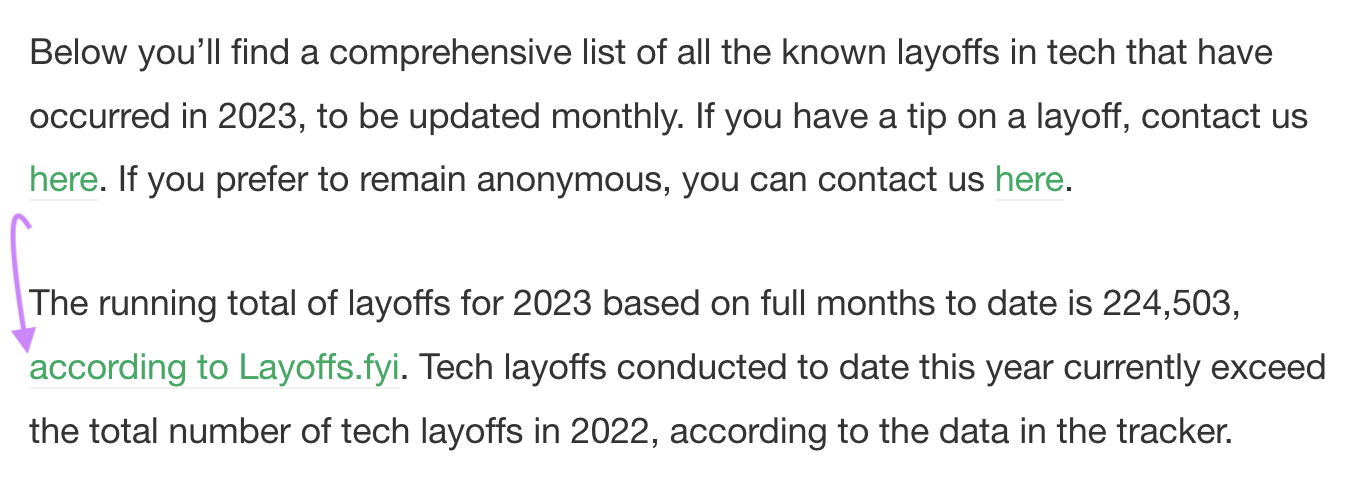

Here are some tactics to build natural, high-quality backlinks:
- Great content: Create original, engaging content that naturally attracts links
- Guest posts: Contribute a guest post for a relevant website in your niche
- HARO: Use HARO (Help a Reporter Out) and respond to journalists’ queries to secure potential backlinks
- Publish original research: Create research reports and pitch them to the media
- Competitor backlink analysis: Analyze your competitors’ backlinks to identify new opportunities for outreach
Semrush’s Link Building tool makes it easier to build high-quality links at scale. It helps you discover new backlink opportunities, connect with relevant websites, and keep track of your backlink profile, simplifying the entire link-building process.
6 Free SEO Insights Tools to Optimize Your Content
To turn these SEO insights into action, you need the right tools. These will help you create content that not only ranks higher, but also resonates with your target audience.
Let’s explore the six free SEO insights tools that can enhance your content optimization efforts and improve your chances of ranking higher.
1. Semrush Organic Traffic Insights
Semrush’s Organic Traffic Insights tool lets you combine data from various sources such as Google Analytics, Google Search Console, and Semrush in a single dashboard like this:

You can analyze your website’s performance and monitor key SEO metrics such as total users, new users, sessions, bounce rate, and average session duration.
The tool also provides a detailed list of keywords that your web pages rank for, including those “not provided” by Google Analytics.
Use this information to spot organic keywords where your website doesn’t make it into the top 10 search results. Then, work on optimizing your website for those keywords to rank better.
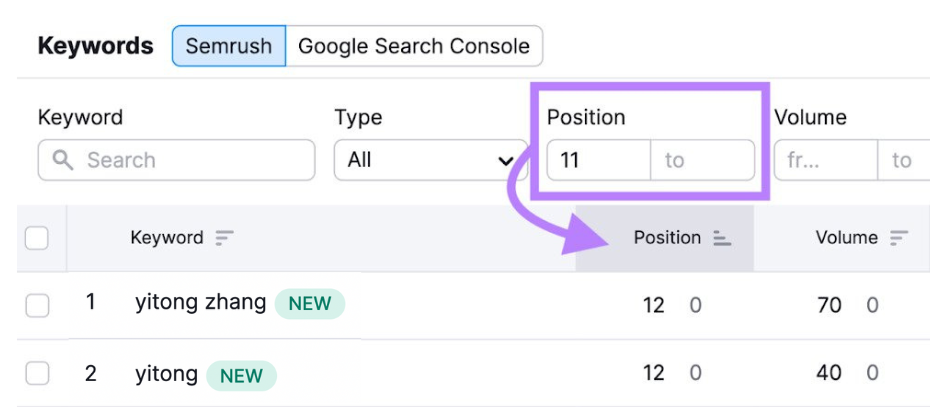
2. Google Search Console
Google Search Console is a free tool that provides data directly from Google, showing how Google views your website.
You can see how effective your SEO efforts are by tracking metrics like clicks, impressions, click-through rates (CTR), and average position.
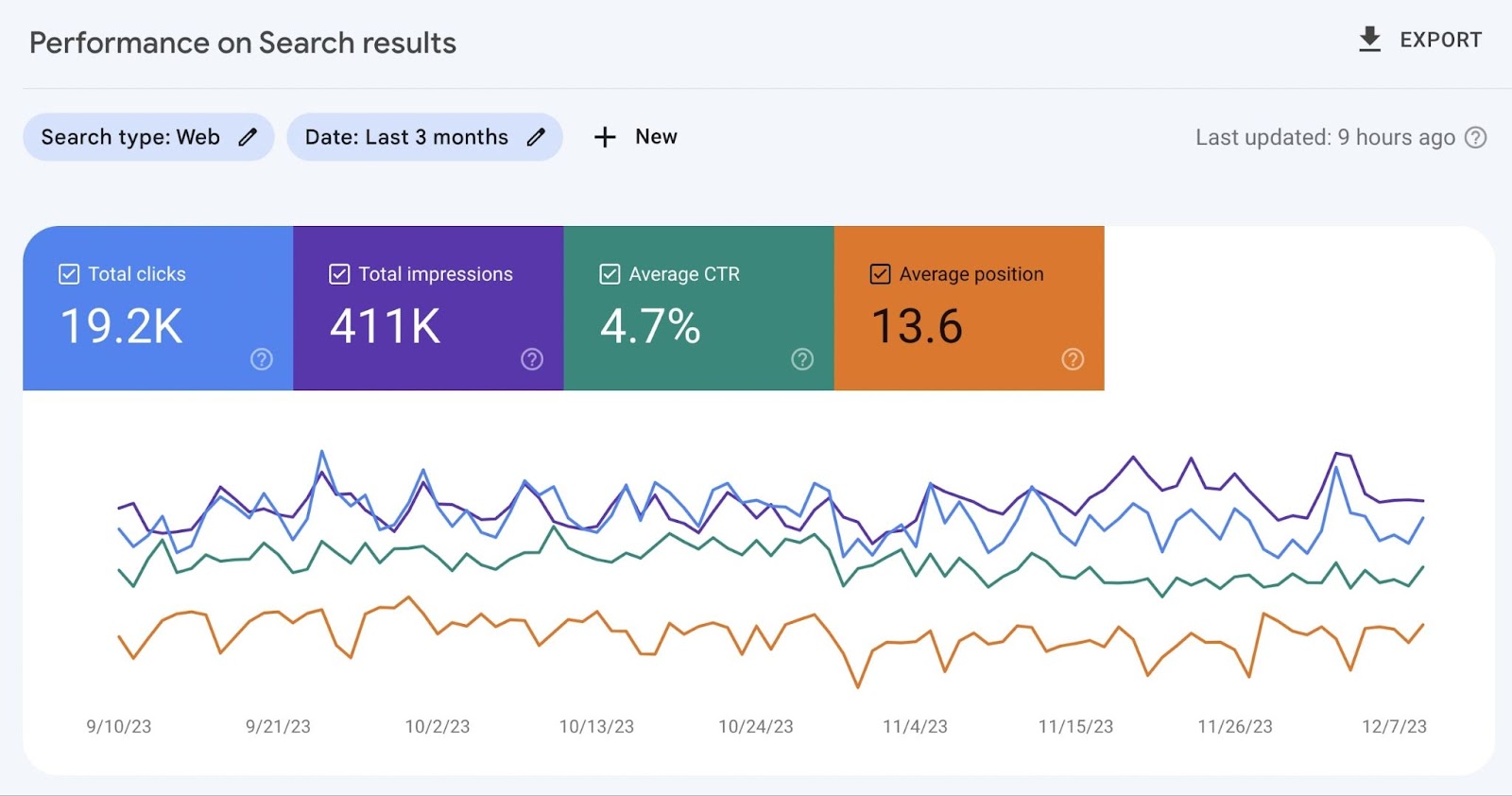
Google Search Console is a useful tool for enhancing technical SEO too. It proactively alerts you about crawl errors that Googlebot finds when it checks your site. This helps you find and fix problems that could hurt your website’s visibility.
The tool goes beyond SEO performance data. It offers insights into your website’s mobile usability. This feature ensures your website works well on mobile, another key ranking factor.
3. SemrushBacklink Analytics
The stronger your backlink profile is, the higher your chances of ranking in search results—and Semrush’s Backlink Analytics tool helps you with just that.
It helps you analyze your backlinks, track their growth, and find new ones with ease. You can also compare your backlink profile with your competitors and identify chances to secure high-quality backlinks.
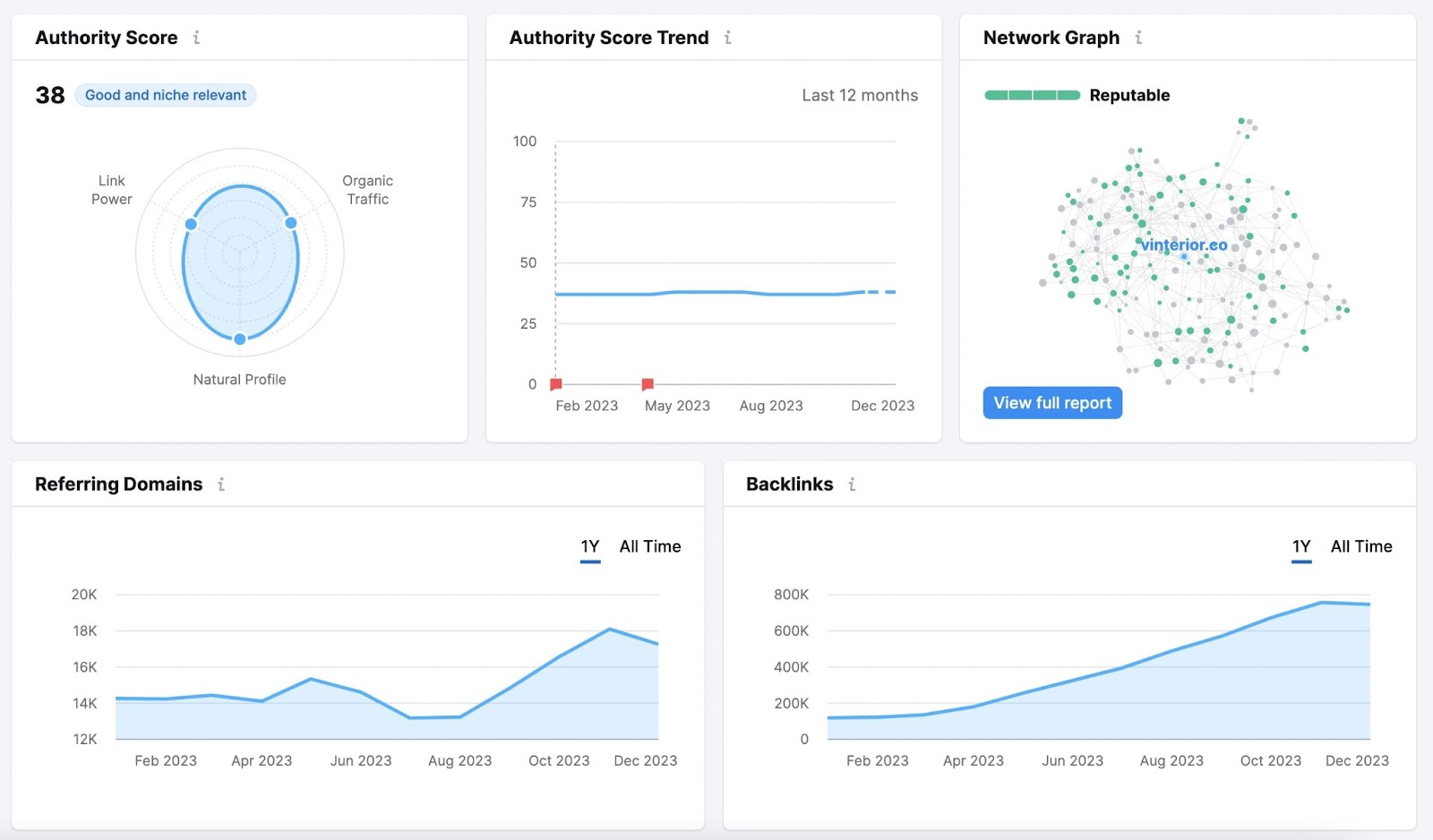
And the best part? It’s the fastest backlink discovery tool, so you can stay ahead of your competitors by being the first to know about their campaigns.
4. Google Analytics
Google Analytics is another free tool that provides data directly from the source.
In addition to insights into traffic sources and keyword research, it also shows you how users interact with your site: pages they visit, how long they stay, and where they drop off.
GA4 also includes more detailed engagement metrics, such as average engagement time (the average time your website was in the website visitor’s foreground).
This data helps you spot content that performs well and where you need to make improvements.
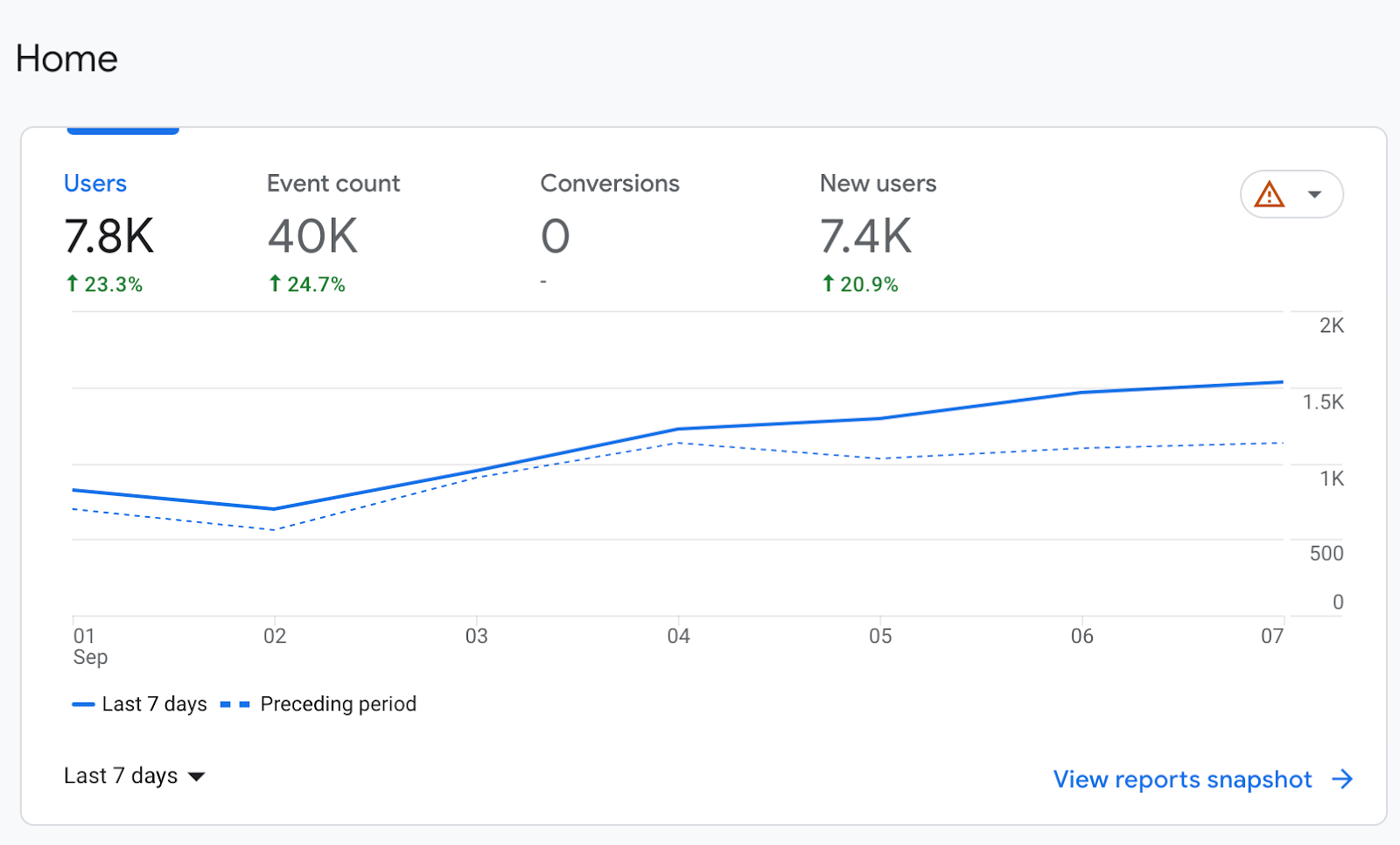
You can also tailor content to your target audience by viewing your website’s audience demographics, including age, gender, location, and interests.
5. SEO Writing Assistant
Semrush’s SEO Writing Assistant can help you optimize your website’s content for search engines.
Using AI and Semrush machine learning algorithms, it suggests ways to improve your content based on the top results for your keyword.
Paste your content into SEO Writing Assistant, then it will give you an overall score out of ten.
It suggests ways to improve your content’s readability, originality, SEO, and tone of voice.
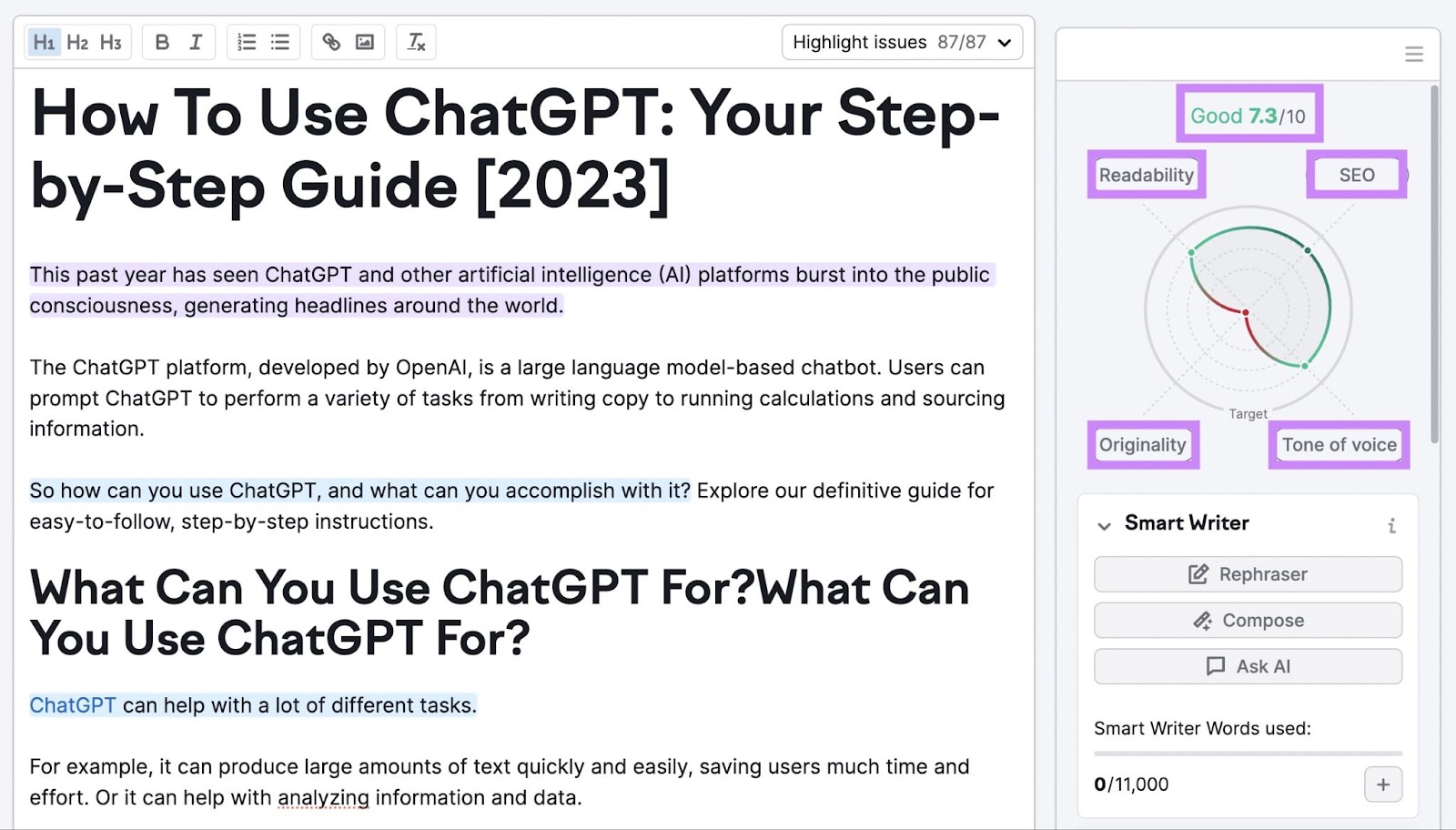
You can get real-time suggestions to optimize your content in Google Docs, Microsoft Word, or WordPress.
SEO Writing Assistant can help you rephrase sentences for clarity.
And its Ask AI feature generates a response to a prompt that can help you flesh out an idea or add extra value to your content, helping boost your search rankings.
6. Google Trends
Google Trends is a valuable SEO insights tool because it provides real-time data on search trends and user interests.
Analyzing the popularity of search teams over time helps you identify emerging trends, seasonal patterns, and changes in user behavior.
Use these insights to create content that aligns with current search trends, ensuring your website remains relevant and appealing to your target audience.
It also allows you to compare the popularity of different keywords. This way you can select the most relevant and high-performing ones for your content optimization efforts.
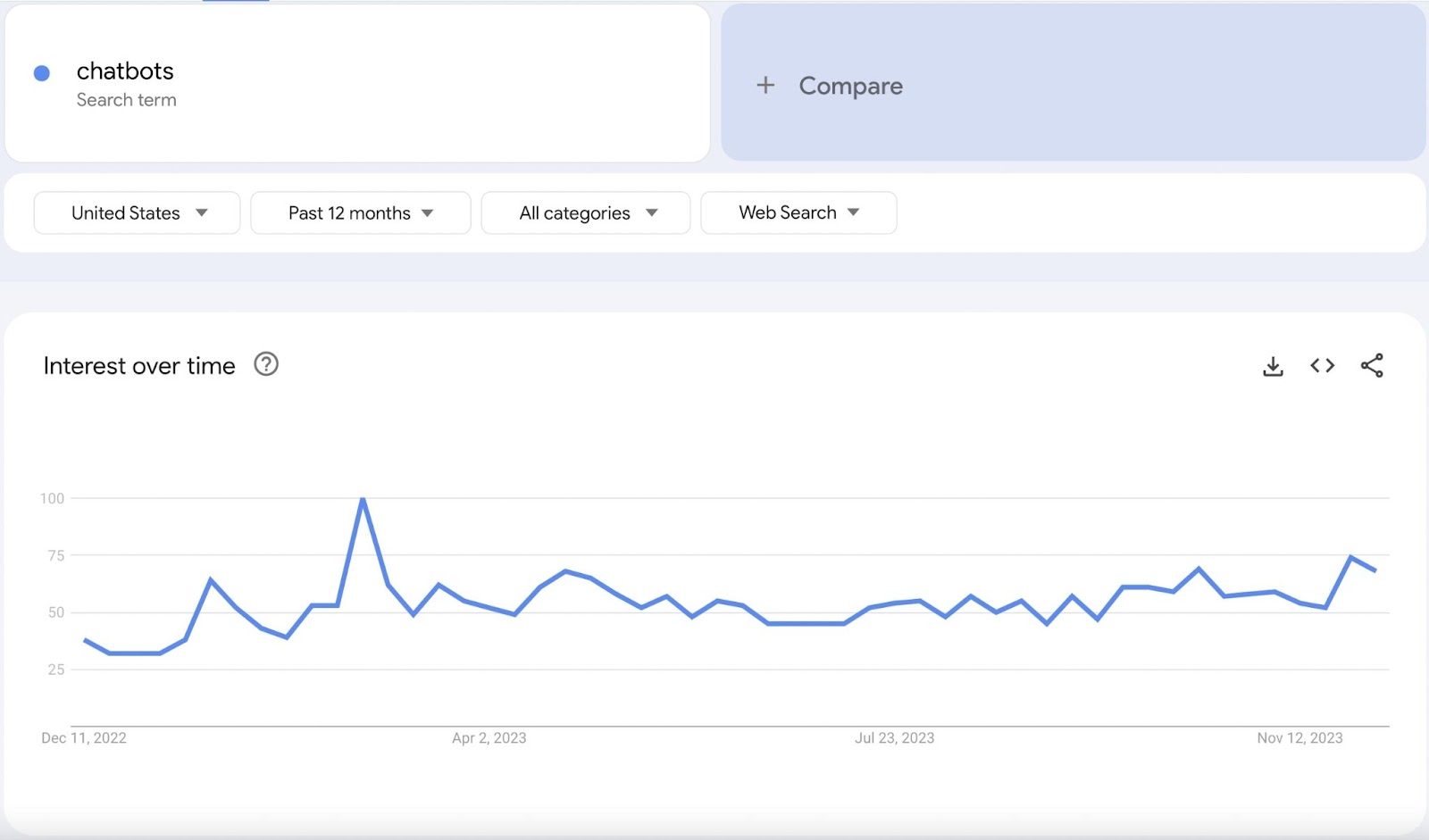
Increase Organic Traffic with SEO Insights and Tools
With these key SEO insights and tools, you’ll be well-equipped to enhance your content marketing strategy and increase your organic traffic in 2023 and beyond.
But remember, search engine optimization is constantly evolving. To stay ahead, you need to continuously learn and adapt. Stay curious, explore new strategies, and keep innovating to stay ahead of the competition.
